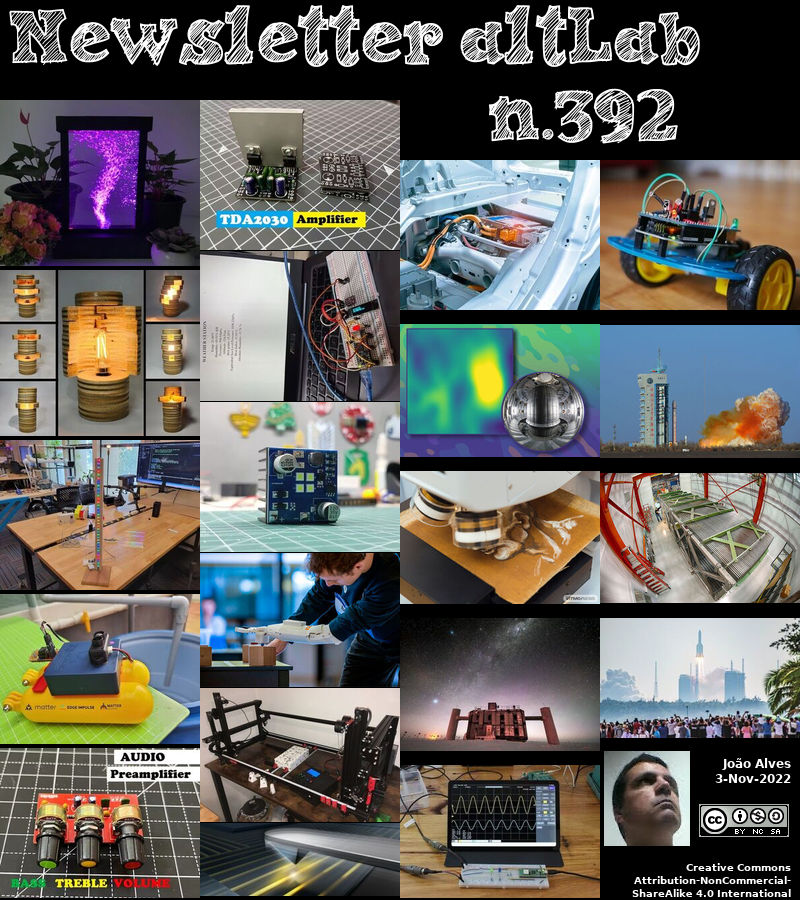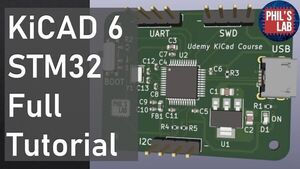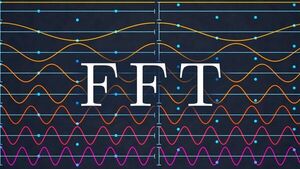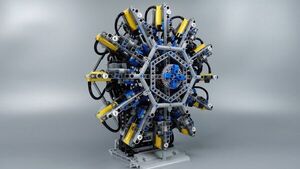2022-11-03 - Nº 392
Editorial
Esta é a Newsletter Nº 392 que se apresenta com o mesmo formato que as anteriores. Se gostar da Newsletter partilhe-a!
Todas as Newsletters encontram-se indexadas no link.
Esta Newsletter tem os seguintes tópicos:
Faz hoje anos que nascia, em 1749, o químico e fotógrafo escocês Daniel Rutherford. Ele descobriu a porção de ar que não suporta a combustão, agora conhecida por ser nitrogénio. Depois de deixar um rato viver numa quantidade confinada de ar até morrer, queimou uma vela e queimou fósforo no mesmo ar, desde que ardessem. Assumiu que o gás restante era dióxido de carbono, que dissolveu passando-o através de um álcali forte. No entanto, permaneceu gás incapaz de suportar a respiração ou combustão, que ele sabia já não conter oxigénio ou dióxido de carbono. Chamou-lhe "ar sofisticado", seguindo a teoria do phlogiston de Georg Stahl. Foi mais tarde devidamente descrito por Antoine Lavoisier. Rutherford também concebeu o primeiro termómetro máximo-mínimo.
Faz igualmente hoje anos que nascia, em 1962, o programador de computador norte-americano Phil Katz. Ele ficou conhecido como o criador do formato de ficheiro Zip para compressão de dados, e o autor de PKZIP, um programa para a criação de ficheiros zip que corria sob DOS. Um processo de direitos de autor entre System Enhancement Associates (SEA) e a empresa de Katz, PKWARE, Inc., foi amplamente divulgado na comunidade BBS no final da década de 1980. O negócio de software de Phil Katz foi muito bem sucedido, mas ele lutou contra o isolamento social e o alcoolismo crónico nos últimos anos da sua vida.
Em 1957, foi lançado o Sputnik 2, com o primeiro animal vivo enviado para o espaço - um cão husky siberiano, Laika ("ladrão" em russo). Pela sua concepção, a embarcação não foi planeada para recuperação, e Laika morreu em órbita. Dados biológicos, os primeiros dados do seu género, foram transmitidos de volta à Terra enquanto ela viveu. Os dados mostraram aos cientistas como Laika se estava a adaptar ao espaço - informação importante para as iminentes missões tripuladas planeadas. O satélite de 508 kg permaneceu em órbita durante 162 dias. Laika foi considerada uma heroína na União Soviética.
Na Newsletter desta semana apresentamos diversas noticias, artigos científicos, projetos de maker e alguns vídeos interessantes.
 João Alves ([email protected])
João Alves ([email protected])
O conteúdo da Newsletter encontra-se sob a licença  Creative Commons Attribution-NonCommercial-ShareAlike 4.0 International License.
Creative Commons Attribution-NonCommercial-ShareAlike 4.0 International License.
Novidades da Semana
Outras Notícias

NASA Prepares to Say ‘Farewell’ to InSight Spacecraft
"The day is approaching when NASA’s Mars InSight lander will fall silent, ending its history-making mission to reveal secrets of the Red Planet’s interior. The spacecraft’s power generation continues to decline as windblown dust on its solar panels thickens, so the team has taken steps to continue as long as possible with what power remains. The end is expected to come in the next few weeks. But even as the tightknit 25-to-30-member operations team – a small group compared to other Mars missions – continues to squeeze the most they can out of InSight (short for Interior Exploration using Seismic Investigations, Geodesy and Heat Transport), they’ve also begun taking steps to wind down the mission. Here’s a glimpse of what that looks like. Preserving Data The most important of the final steps with the InSight mission is storing its trove of data and making it accessible to researchers around the world." [...]

TI unifies fragmented IoT ecosystems with Matter-enabled wireless MCU software
"Engineers can reliably and securely connect devices across branded smart home ecosystems on Wi-Fi® and Thread networks Enabling smarter connections to the world around us, Texas Instruments (TI) (Nasdaq: TXN) today introduced new Matter-enabled software development kits for Wi-Fi and Thread SimpleLink™ wireless microcontrollers (MCUs) that will streamline adoption of the Matter protocol in Internet of Things (IoT) applications. The software builds on TI’s close involvement with the Connectivity Standards Alliance and innovation in the 2.4-GHz connectivity space. Engineers can use the new software and wireless MCUs such as the CC3235SF and CC2652R7 to create ultra-low-power and secure, battery-powered smart home and industrial automation IoT applications that seamlessly connect with devices across proprietary ecosystems. Learn more about making connections simpler, more secure and scalable with the foundation for connected things in home and building automation applications at www.ti.com/matter. "In a matter of weeks, we’re quickly seeing alliance members building on the new capabilities of Matter and bringing innovation to the ecosystem, in this case a streamlined approach for MCUs and IoT applications over Wi-Fi and Thread," said Chris LaPre, Head of Technology at the Connectivity Standards Alliance. "TI’s new wireless MCUs for IoT applications will help designers seamlessly and securely connect with interoperable Matter devices."" [...]
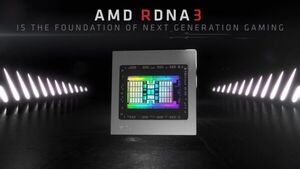
AMD Unveils World’s Most Advanced Gaming Graphics Cards, Built on Groundbreaking AMD RDNA 3 Architecture with Chiplet Design
"Highly efficient AMD RDNA 3 architecture delivers world-class performance, and features new unified compute units, world’s fastest interconnect, second-generation AMD Infinity Cache technology, new display and media engines, and more AMD today unveiled new graphics cards built on the next-generation high-performance, energy-efficient AMD RDNA™ 3 architecture – the AMD Radeon™ RX 7900 XTX and Radeon RX 7900 XT graphics cards. Following on the highly successful AMD “Zen”-based AMD Ryzen™ chiplet processors, the new graphics cards are the world’s first gaming graphics cards to feature an advanced AMD chiplet design. They deliver exceptional performance and superb energy efficiency to power high-framerate 4K and higher resolution gaming in the most demanding titles. The AMD RDNA 3 architecture’s chiplet design combines 5nm and 6nm process nodes, each optimized for specific jobs. The breakthrough architecture delivers up to 54% more performance per watt than AMD RDNA 2 architecture1, and features the world’s fastest interconnect linking the graphics and memory system chiplets at up to 5.3 TB/s2. It also offers up to 96 new unified compute units, second-generation AMD Infinity Cache™ technology, and up to 24 GB of high-speed GDDR6 memory with up to a 384-bit memory interface." [...]

Renesas Introduces New ASIL B Power Management IC Ideal for Automotive Camera Applications
"Highly Integrated RAA271082 PMIC Complements Renesas’ Award-Winning AHL Technology; Flexibility Enables Support for MCUs in Safety-Related Applications Renesas Electronics Corporation (TSE:6723), a premier supplier of advanced semiconductor solutions, today unveiled an innovative automotive power management IC (PMIC) for next-generation automotive camera applications. The RAA271082 is a versatile ISO-26262 compliant multi-rail power IC with a primary high voltage synchronous buck regulator, two secondary low voltage synchronous buck regulators, and a low voltage LDO regulator. It offers four overvoltage and undervoltage (OV/UV) monitors, I2C communications, a configurable general-purpose I/O pin, and a dedicated reset output/fault indicator. To meet stringent ASIL B metrics, the RAA271082 includes a second independent reference for OV/UV monitors, built-in self-test at power-up, independent OV/UV monitoring, and continuous CRC error checking on internal registers and I2C communications. The highly integrated RAA271082 provides a universal power solution for automotive cameras. It is an ideal companion for Renesas’ Automotive High-Definition Link (AHL) technology that enables car manufacturers to deliver high-definition video using low-cost cables and connectors." [...]

Samsung Launches AccE Glass-Free Detector for X-Ray Imaging
"Representing the company’s philosophy of “relentless innovation,” this new solution provides a comfortable image experience for both patients and users To optimize work efficiency and portability, Samsung has introduced a new flagship detector, the AccE Glass-Free Detector. The AccE Glass-Free Detector recently received 510(k) clearance from the U.S. Food and Drug Administration for commercial use in the USA. “Being at the forefront of advancing healthcare imaging, we have recognized the need for new solutions that enhance both patient and user comfortability,” said David Legg, Vice President, Head of Boston Imaging. “From the ER to the OR, our Glass-Free Detector exhibits reliability in versatile environments to help get the job done — and done well.” The AccE Glass-Free Detector was designed to deliver high-resolution images of a digital detector, while offering exceptional user and patient benefits, including: The AccE Glass-Free Detector was designed to deliver high-resolution images of a digital detector, while offering exceptional user and patient benefits, including: - Lightweight Design: Weighs approximately 4.5 pounds,1 which is 27 percent lighter than the conventional model.2 - Clear Visibility: Exhibits a 76% DQE, leading the market in glassless panel technology. - Functionality: Features a non-glass flexible panel with center-engraving to position a patient, a side chamfer to ease lifting and a rear grip to support transportation. - High Load Allowance: Holds up to 881 pounds of surface load and 441 pounds of patient load.3 - Dust and Water Resistant: Enables users to employ the detector with confidence in fast-paced environments." [...]

SpaceX launches Hotbird 13G telecom satellite, lands rocket at sea
"SpaceX launched a telecom satellite to orbit and landed a rocket on a ship at sea early Thursday (Nov. 3). A Falcon 9 rocket carrying Eutelsat's Hotbird 13G satellite lifted off from Florida's Cape Canaveral Space Force Station Thursday at 1:22 a.m. EDT (0522 GMT). The Falcon 9's first stage returned to Earth a little less than nine minutes later, touching down as planned on SpaceX's Just Read the Instructions droneship, which was stationed in the Atlantic Ocean. It was the seventh launch and landing for this particular first stage. "The Falcon 9 first stage booster supporting this mission previously launched CRS-22, Crew-3, Turksat 5B, Crew-4, CRS-25, and one Starlink mission," SpaceX wrote in a prelaunch mission description(opens in new tab). (Crew-3 and Crew-4 were astronaut missions to the International Space Station, and CRS-22 and CRS-25 were uncrewed cargo flights to the orbiting lab.)" [...]
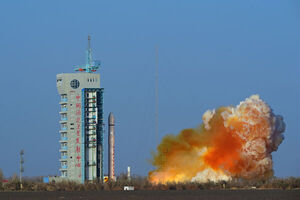
China Launches Experimental Satellite into Space
"China launched a Long March 2D carrier rocket on Saturday morning to transport an experimental satellite into space, according to China Aerospace Science and Technology Corp. The State-owned space conglomerate said in a press release that the rocket blasted off at 9:01 am at the Jiuquan Satellite Launch Center in northwestern China and soon sent the Shiyan 20C, or Experiment 20C, into its preset orbit. The satellite has been designed and built by the Shanghai-based Innovation Academy for Microsatellites of the Chinese Academy of Sciences. It is tasked with demonstrating new technologies used for purposes such as space environmental monitoring. Long March 2D, made by the company's Shanghai Academy of Spaceflight Technology, is propelled by liquid propellants and has a liftoff thrust of 300 metric tons. It is capable of sending a 1.3-ton spacecraft to a sun-synchronous orbit with an altitude of 700 kilometers." [...]

China successfully launches final part of its three-module space station, to complete T-shape structure assembly
"China successfully launched Mengtian lab module - the third and final part of its three-module home-developed space station - into preset orbit, on Monday afternoon from South China's tropical island province of Hainan, kicking start the final battle of completing the country's T-shape and first-ever permanent space station. Mengtian, also the second lab module, will be the last piece before China completes the space station assembly. Carrying the Mengtian lab module, China's mega Long March-5B Y4 carrier rocket took off from the Wenchang Space Launch Site around 3:37 pm on Monday. And after a flight of around eight minutes, the module separated with the rocket and entered its designated orbit, marking the success of the launch mission, the Global Times learned from the China Manned Space Agency (CMSA). Following the successful launch, Mengtian will carry out a fast and automated rendezvous and docking with the Tianhe space station core module at the latter's forward docking port, per the CMSA. The new lab module will then be transpositioned from the forward docking port on Tianhe to the port docking ring on the side, joining the two earlier modules - Tianhe core module and Wentian lab module, to complete the T-shape China Space Station basic structure." [...]
Ciência e Tecnologia

New MicroBooNE Analysis Takes a Closer Look at the Sterile Neutrino
"The MicroBooNE collaboration at Fermilab has released a new analysis of their neutrino data. The result provides constraints on a model that assumes the existence of a sterile neutrino to explain anomalies in neutrino measurements by other experiments A new result from the MicroBooNE experiment at the U.S. Department of Energy’s Fermi National Accelerator Laboratory probes the Standard Model—scientists’ best theory of how the universe works. The model assumes there are three kinds of neutrinos. Yet for more than two decades, a proposed fourth kind of neutrino has remained a promising explanation for anomalies seen in earlier physics experiments. Finding the theorized sterile neutrino would be a major discovery and radical shift in our understanding of the universe. The new analysis compares the experiment’s data to a model with a fourth, sterile neutrino to test their compatibility." [...]

ITMO Scientists Create Method to Quickly Detect Painting Authenticity
"In collaboration with the staff of the State Russian Museum, researchers from ITMO University have developed a new method for detecting painting authenticity with infrared spectroscopy. The method will allow the museum’s experts to quickly identify a painting’s chemical compounds and the century it was created in, as was demonstrated by a test analysis performed on a copy of one of Ivan Aivazovsky’s creations. In the future, the new method will help identify the authenticity of pieces from the era of Russian avant-garde. Chemistry and ownership in one study Some of the common methods to identify a painting’s authenticity are ultraviolet luminescence, X-ray diffraction, infrared reflectography, and X-ray fluorescence. However, all of them allow specialists to analyze only a painting’s exterior, without looking into the molecular compounds of the paint used to create it. Researchers from ITMO’s have developed a semiquantative method based on infrared spectroscopy that can solve several tasks in just 30 seconds." [...]

Enlightened route to wireless communications
"Smart windows that can polarize sunlight could offer a low energy alternative to Wi-Fi. Sunshine streaming through a window could be directly harnessed for wireless data transmission to electronic devices. KAUST researchers have designed a smart glass system that can modulate the sunlight passing through it, encoding data into the light that can be detected and decoded by devices in the room. The use of sunlight to send data would offer a greener mode of communication compared to conventional Wi-Fi or cellular data transmission. Basem Shihada had been exploring data encoding into an artificial light source when he had the lightbulb moment to use sunshine. “I was simply hoping to use a cell phone camera to record a video of the encoded light stream to try to decode the video to retrieve the data; that's when I thought, why not do the same with the sunlight?” Shihada recalls." [...]
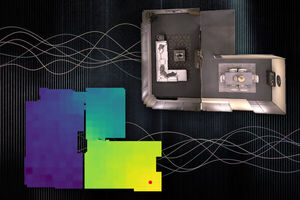
Using sound to model the world
"This machine-learning system can simulate how a listener would hear a sound from any point in a room. Imagine the booming chords from a pipe organ echoing through the cavernous sanctuary of a massive, stone cathedral. The sound a cathedral-goer will hear is affected by many factors, including the location of the organ, where the listener is standing, whether any columns, pews, or other obstacles stand between them, what the walls are made of, the locations of windows or doorways, etc. Hearing a sound can help someone envision their environment. Researchers at MIT and the MIT-IBM Watson AI Lab are exploring the use of spatial acoustic information to help machines better envision their environments, too. They developed a machine-learning model that can capture how any sound in a room will propagate through the space, enabling the model to simulate what a listener would hear at different locations." [...]
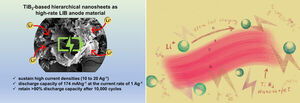
The Answer is in the Sheets: 2D Nanosheets as Anodes in Li-Ion Batteries
"Researchers from Japan and India use titanium diboride nanosheets as anode material in lithium-ion batteries to enable fast charging and extend battery life. Lithium-ion batteries are ubiquitous in the world of electric vehicles. However, a significant challenge encountered with their use is their low battery life and slow charging capability. Recent studies suggest two-dimensional (2D) nanomaterials to be a strong candidate for enhancing their performance. Recently, a collaborative research team from Japan and India demonstrated the efficacy of using 2D titanium diboride nanosheets in lithium-ion batteries. Their findings could have far-reaching consequences in the field of electric vehicles and other electronics." [...]

In machine learning, synthetic data can offer real performance improvements
"Models trained on synthetic data can be more accurate than other models in some cases, which could eliminate some privacy, copyright, and ethical concerns from using real data. Teaching a machine to recognize human actions has many potential applications, such as automatically detecting workers who fall at a construction site or enabling a smart home robot to interpret a user’s gestures. To do this, researchers train machine-learning models using vast datasets of video clips that show humans performing actions. However, not only is it expensive and laborious to gather and label millions or billions of videos, but the clips often contain sensitive information, like people’s faces or license plate numbers. Using these videos might also violate copyright or data protection laws. And this assumes the video data are publicly available in the first place — many datasets are owned by companies and aren’t free to use." [...]

Entering a New Phase: NIST Technique Simultaneously Locates Multiple Defects on Microchip Circuits
"Defective computer chips are the bane of the semiconductor industry. Even a seemingly minor flaw in a chip packed with billions of electrical connections might cause a critical operation in a computer or other sensitive electronic device to fail. By modifying an existing technique for identifying defects, researchers at the National Institute of Standards and Technology (NIST) have developed a method that can simultaneously locate individual electrical flaws in multiple microcircuits on the same chip. Because the technique relies on a relatively inexpensive and common imaging tool, an atomic force microscope (AFM), it may provide a new way to test the interconnected wiring of computer chips in the factory. An AFM features an ultrasharp tip attached to a tiny cantilever that vibrates like a diving board. In the standard mode of operation, scientists apply an AC (alternating current) voltage to the tip as it scans across individual wires buried in parallel several micrometers (millionths of a meter) below the surface of a silicon chip." [...]
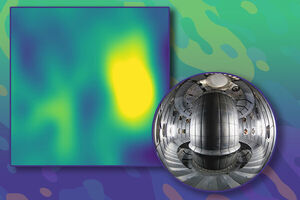
Machine learning facilitates “turbulence tracking” in fusion reactors
"A new approach sheds light on the behavior of turbulent structures that can affect the energy generated during fusion reactions, with implications for reactor design. Fusion, which promises practically unlimited, carbon-free energy using the same processes that power the sun, is at the heart of a worldwide research effort that could help mitigate climate change. A multidisciplinary team of researchers is now bringing tools and insights from machine learning to aid this effort. Scientists from MIT and elsewhere have used computer-vision models to identify and track turbulent structures that appear under the conditions needed to facilitate fusion reactions. Monitoring the formation and movements of these structures, called filaments or “blobs,” is important for understanding the heat and particle flows exiting from the reacting fuel, which ultimately determines the engineering requirements for the reactor walls to meet those flows. However, scientists typically study blobs using averaging techniques, which trade details of individual structures in favor of aggregate statistics." [...]
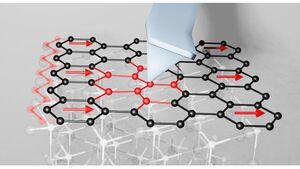
NYU Tandon researchers explore a more frictionless future
"Elisa Riedo’s and her lab team’s discovery of a fundamental law of friction leads to new materials that can minimize energy loss Professor of Chemical and Biomolecular Engineering Elisa Riedo and her team have discovered a fundamental friction law that is leading to a deeper understanding of energy dissipation in friction and the design of two-dimensional materials capable of minimizing energy loss. Friction is an everyday phenomenon; it allows drivers to stop their cars by breaking and dancers to execute complicated moves on various floor surfaces. It can, however, also be an unwanted effect that drives the waste of large amounts of energy in industrial processes, the transportation sector, and elsewhere. Tribologists — those who study the science of interacting surfaces in relative motion — have estimated that one-quarter of global energy losses are due to friction and wear. While friction is extremely widespread and relevant in technology, the fundamental laws of friction are still obscure, and only recently have scientists been able to use advances in nanotechnology to understand, for example, the microscopic origin of da Vinci’s law, which holds that frictional forces are proportional to the applied load. Now, Riedo and her NYU Tandon postdoctoral researcher Martin Rejhon have found a new method to measure the interfacial shear between two atomic layers and discovered that this quantity is inversely related to friction, following a new law." [...]
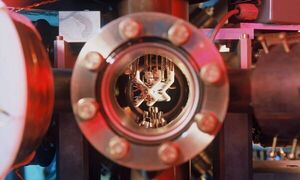
Method to characterize large quantum computers
"Quantum devices are becoming ever more complex and powerful. Researchers at the University of Innsbruck, in collaboration with the Johannes Kepler University Linz and the University of Technology Sydney, are now presenting a method to characterize even large quantum computers using only a single measurement setting. The gold-standard for the characterization of quantum devices is so-called quantum tomography, which in analogy to medical tomography, can draw a complete picture of a quantum system from a series of snapshots of the system. While offering plenty of insights, the number of measurements required for tomography increases rapidly, with three times as many measurements required for every additional qubit. Due to the sheer time it takes to perform all these measurements, tomography has only been possible on devices with a handful of qubits. However, recent developments on quantum computers have successfully scaled up system sizes much beyond the capabilities of tomography, making their characterization a daunting bottleneck." [...]

Can cosmic inflation be ruled out?
"Astrophysicists say that cosmic inflation – a point in the Universe’s infancy when space-time expanded exponentially, and what physicists really refer to when they talk about the ‘Big Bang’ – can in principle be ruled out in an assumption-free way. The astrophysicists, from the University of Cambridge, the University of Trento, and Harvard University, say that there is a clear, unambiguous signal in the cosmos which could eliminate inflation as a possibility. Their paper, published in The Astrophysical Journal Letters, argues that this signal – known as the cosmic graviton background (CGB) – can feasibly be detected, although it will be a massive technical and scientific challenge. “Inflation was theorised to explain various fine-tuning challenges of the so-called hot Big Bang model,” said the paper’s first author Dr Sunny Vagnozzi, from Cambridge’s Kavli Institute for Cosmology, and who is now based at the University of Trento. “It also explains the origin of structure in our Universe as a result of quantum fluctuations. “However, the large flexibility displayed by possible models for cosmic inflation which span an unlimited landscape of cosmological outcomes raises concerns that cosmic inflation is not falsifiable, even if individual inflationary models can be ruled out." [...]
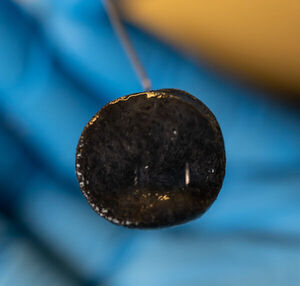
Bacterial sensors send a jolt of electricity when triggered
"Rice labs’ Nature paper introduces groundbreaking bioelectronic devices When you hit your finger with a hammer, you feel the pain immediately. And you react immediately. But what if the pain comes 20 minutes after the hit? By then, the injury might be harder to heal. Scientists and engineers at Rice University say the same is true for the environment. If a chemical spill in a river goes unnoticed for 20 minutes, it might be too late to remediate." [...]

Introducing a novel molecular orbital interaction that stabilises cathode materials for lithium-ion batteries
"A large international team led by scientists from the Institute for Superconducting and Electronic Materials at the University of Wollongong has verified that the introduction of novel molecular orbital interactions can improve the structural stability of cathode materials for lithium-ion batteries. The production of better cathode materials for high-performance lithium-ion batteries is a major challenge for the electric car industry. In research published in Angewandte Chemie, first author Dr Gemeng Liang, Prof Zaiping Guo, A/Prof Wei Kong Pang and associates, used multiple capabilities at ANSTO and other techniques to provide evidence that doping a promising cathode material, spinel LiNi0.5 Mn1.5 O4 (LNMO), with germanium significantly strengthens the 4s-2p orbital interaction between oxygen and metal cations. “The 4s-2p orbital is relatively uncommon, but we found a compound in the literature in which germanium has a valence state of + 3, enabling an electron configuration ([Ar] 3d104s1) in which 4s transition metal orbital electrons are available to interact with unpaired electrons in the oxygen 2p orbital, producing the hybrid 4s-2p orbital, ”explained Dr Liang. The 4s-2p orbital creates structural stability in the LNMO material, as determined using synchrotron and neutron experiments at ANSTO’s Australian Synchrotron and the Australian Centre for Neutron Scattering, as well as other methods. The team used neutron and (lab-based) X-ray powder diffraction, as well as microscopy, to confirm the location of the doped germanium at the 16c and 16d crystallographic sites of the LNMO structure with space group symmetry." [...]
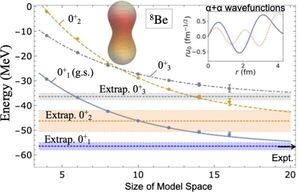
LSU Researchers Collaborate to Better Understand the Weak Nuclear Force
"Physics journal PRL features LSU nuclear physics research. Physical Review Letters, PRL, the world’s premier physics letter journal, has published two papers by a team of Louisiana State University nuclear physics researchers to advance the knowledge on the important implications for understanding the physics of the weak nuclear force. The weak nuclear force is currently not entirely understood, despite being one of the four fundamental forces of nature. In a pair of Phys. Rev. Lett." [...]

Quantum dots form ordered material
"Finding paves the way for new generation of opto-electronic applications. Quantum dots are clusters of some 1,000 atoms which act as one large ‘super-atom’. It is possible to accurately design the electronic properties of these dots just by changing their size. However, to create functional devices, a large number of dots have to be combined into a new material. During this process, the properties of the dots are often lost. Now, a team led by University of Groningen professor of Photophysics and Optoelectronics, Maria Antonietta Loi, has succeeded in making a highly conductive optoelectronic metamaterial through self-organization." [...]

New Tech Solves Longstanding Challenges for Self-Healing Materials
"Engineering researchers have developed a new self-healing composite that allows structures to repair themselves in place, without having to be removed from service. This latest technology resolves two longstanding challenges for self-healing materials, and can significantly extend the lifespan of structural components such as wind-turbine blades and aircraft wings. “Researchers have developed a variety of self-healing materials, but previous strategies for self-healing composites have faced two practical challenges,” says Jason Patrick, corresponding author of the research paper and an assistant professor of civil, construction and environmental engineering at North Carolina State University. “First, the materials often need to be removed from service in order to heal. For instance, some require heating in an oven, which can’t be done for large components or while a given part is in use. Second, the self-healing only works for a limited period." [...]
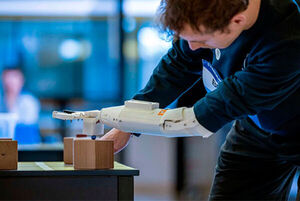
Engineering students from the UPC create a 3D-printed functional robotic arm
"The Arm2u biomedical engineering team, from the UPC’s Barcelona School of Industrial Engineering (ETSEIB), has designed and manufactured using 3D printing technology a customisable transradial prosthesis that responds to the user’s nerve impulses. Fifteen bachelor’s and master’s degree students from the Barcelona School of Industrial Engineering (ETSEIB) of the Universitat Politècnica de Catalunya · BarcelonaTech (UPC) share the same dream: improving the quality of life of people with disabilities using assistive technologies. Specifically, the young biomedical engineering team Arm2u is developing a transradial prosthesis—which replaces an arm missing below the elbow—with myoelectric control, i.e. controlled by the natural electrical signals produced by muscle contraction. After creating a first prosthesis last year, the team has taken a step forward by creating a second prototype, a fully functional robotic arm that enables hand pronosupination (forearm rotation) and opening/closing movements. It is based on EMG sensors, which collect the commands from the patient’s muscle contraction and transforms these electrical impulses into a signal that the microcontroller can understand and use." [...]
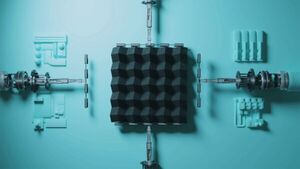
These engineers drew inspiration from geometrical frustration
"Springs, squeegees and soda straws function with a common property — they are rigid in one direction and flexible in another. Structures like these, with properties that vary across dimensions, have played critical roles in human technology from the longbow to the booster rocket. Now, researchers have drawn inspiration from the art of origami to create programmable surfaces that allow engineers to alter physical properties of a uniform substance across a range of directions. In an article published in the Oct. 26 issue of the journal Advanced Materials, the researchers described structures that are also programmable, so dimensions and corresponding properties can shift as needed. The researchers hope that designers will be able to apply the techniques to medical devices, architecture, robotics and aerospace. “We have an almost infinite number of adjustments, which provide a rich design space,” said Glaucio Paulino, the Margareta Engman Augustine Professor of Engineering and one of the principal researchers." [...]
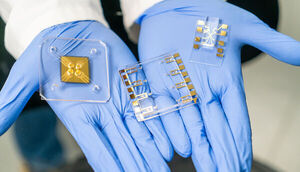
New technology developed for single-cell analysis
"The ability to analyze the properties of individual cells is vital to broad areas of life science applications, from diagnosing diseases and developing better therapeutics to characterizing pathogenic bacteria and developing cells for bioproduction applications. However, the accurate analysis of individual cells is a challenge, especially when it comes to a cell’s biophysical properties, due to large property variations among cells even in the same cell population as well as the presence of rare cell types within a larger population. Addressing this need, Dr. Arum Han, Texas Instruments Professor II in the Department of Electrical and Computer Engineering at Texas A&M University, together with his graduate students and postdoctoral researchers, have developed a new technology that can accurately analyze cell properties through the use of a single-cell electrorotation microfluidic device, which utilizes an electric field to probe the cell’s properties. The technology works by using an electric field to first capture a single cell in a microfluidic device, followed by applying a rotating electric field to rotate the trapped single cell and then measuring the speed of rotation. By knowing the input electric field parameters and analyzing the rotation speed, accurately analyzing the dielectric properties of a single cell becomes possible. “By knowing how much force was applied and how fast the cell turns, you can extract many basic biophysical properties of cells,” Han said." [...]
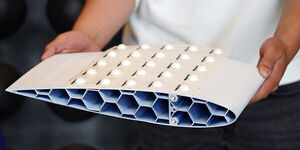
Borrowing a shape from a to-go cup lid, a drone wing could learn how to sense danger faster
"The oddly satisfying small domes that you press on your soda’s to-go cup lid may one day save a winged drone from a nosedive. Patterns of these invertible domes on a drone’s wings would give it a way to remember in microseconds what dangerous conditions feel like and react quickly. The study, conducted by researchers at Purdue University and the University of Tennessee, Knoxville, is among the first demonstrations of a metamaterial that uses its shape to learn how to adapt to its surroundings on its own. The paper is published in the journal Advanced Intelligent Systems. Unlike humans and other living beings, autonomous vehicles lack ways to filter out information they don’t need, which slows their response time to changes in their environment. “There’s this problem called ‘data drowning.’ Drones cannot use their full flight capability because there is just too much data to process from their sensors, which prevents them from flying safely in certain situations,” said Andres Arrieta, a Purdue associate professor of mechanical engineering with a courtesy appointment in aeronautical and astronautical engineering." [...]
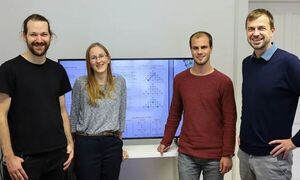
New form of universal quantum computers
"Computing power of quantum machines is currently still very low. Increasing it is still proving to be a major challenge. Physicists at the University of Innsbruck now present a new architecture for a universal quantum computer that overcomes such limitations and could be the basis of the next generation of quantum computers soon. Quantum bits (qubits) in a quantum computer serve as a computing unit and memory at the same time. Because quantum information cannot be copied, it cannot be stored in a memory as in a classical computer. Due to this limitation, all qubits in a quantum computer must be able to interact with each other." [...]

Ultra-cold mini twisters
"A team of quantum physicists from Innsbruck, Austria, led by three-time ERC laureate Francesca Ferlaino has established a new method to observe vortices in dipolar quantum gases. These quantum vortices are considered a strong indication of superfluidity, the frictionless flow of a quantum gas, and have now been experimentally detected for the first time in dipolar gases. Vortices are ubiquitous in nature: Whirling up water can create swirls. When the atmosphere is stirred up, huge tornadoes can form. This is also the case in the quantum world, except that there many identical vortices are being formed simultaneously - the vortex is quantized. In many quantum gases, such quantized vortices have already been demonstrated." [...]

World's first optical atomic clock with highly charged ions
"Optical atomic clocks are the most accurate measuring instruments ever built and are becoming key tools for basic and applied research, for example to test the constancy of natural constants or for height measurements in geodesy. Now, researchers at the QUEST Institute at the Physikalisch-Technische Bundesanstalt (PTB), in collaboration with the Max Planck Institute for Nuclear Physics (MPIK) and the TU Braunschweig and in the scope of the QuantumFrontiers Cluster of Excellence, have realised for the first time an optical atomic clock based on highly charged ions. This type of ion lends itself to such an application because it has extraordinary atomic properties and low sensitivity to external electromagnetic fields. The researchers report on their results in the current issue of Nature. Highly charged ions are a common form of matter in the cosmos, where they are found, for example, in the sun or other stars. They are so called because they have lost many electrons and therefore have a high positive charge." [...]
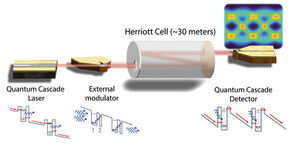
Higher speeds in free-space optical communications in the midinfrared band
"Unipolar quantum optoelectronic devices show potential for fast, long-range optical links that are also resistant to adverse weather conditions. Telecommunications have reshaped many aspects of our lives over the past few decades by providing incredibly convenient ways to share and access information. One of the most important enablers for this transformation has been the adoption and improvement of broadband technologies, which cram enormous amounts of data over wide frequency bands to achieve unprecedented transfer speeds. Today, most large cities have fiber optics-based networks that distribute high-speed internet directly to every home. Unfortunately, it is not always feasible to deploy fiber optic links to remote locations and rural areas, due to the associated costs and civil engineering work required. Such places could benefit from a different approach to optical broadband communications: free-space optics." [...]
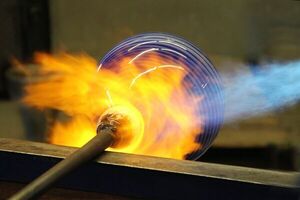
New advances in understanding glass-to-liquid transition
"As time passes, glass restructures itself towards more stable configurations which can affect its properties. Given that glass has numerous practical applications, knowing how this transition takes place is highly relevant. Researchers from the UAB Department of Physics and from the ICN2 explain how they studied the details of glass transition and observed how the restructuring of glass when turning into liquid is not always a homogeneous process, depending more on the temperature instead of the initial stability of the glass. Starting from the windows of our houses to communication via optical fiber, pharmaceuticals, the plastic industry or organic electronics, disorder is present in our lives. All these materials share a common characteristic, the lack of short-range order of the atoms and molecules that form the material, they are what we call glasses. This disorder has advantages such as transparency, better solubility, elasticity or homogeneity, depending on the material and the use you want to give it." [...]

UW–Madison researchers key in revealing neutrinos emanating from galactic neighbor with a gigantic black hole
"On Earth, billions of subatomic particles called neutrinos pass through us every second, but we never notice because they rarely interact with matter. Because of this, neutrinos can travel straight paths over vast distances unimpeded, carrying information about their cosmic origins. Although most of these aptly named “ghost” particles detected on Earth originate from the Sun or our own atmosphere, some neutrinos come from the cosmos, far beyond our galaxy. These neutrinos, called astrophysical neutrinos, can provide valuable insight into some of the most powerful objects in the universe. For the first time, an international team of scientists has found evidence of high-energy astrophysical neutrinos emanating from the galaxy NGC 1068 in the constellation Cetus. The detection was made by the National Science Foundation-supported IceCube Neutrino Observatory, a 1-billion-ton neutrino telescope made of scientific instruments and ice situated 1.5-2.5 kilometers below the surface at the South Pole." [...]

‘Stretched’ nuclear states under the magnifying glass at the Cracow cyclotron
"All chemical elements were formed in the process of evolution of the Universe dominated by light atomic nuclei. The properties of these nuclei are therefore of crucial importance not only in astrophysics, but also in relation to our everyday life. Our knowledge of light atomic nuclei has just been expanded thanks to accelerator studies conducted in Cracow on the specific excited states of carbon-13 nuclei. The precise observation of phenomena occurring in atomic nuclei, especially of high-energy states, is an extremely difficult task from both technical and theoretical aspects. However, there are varieties of high-lying excitations of atomic nuclei that, due to their specific structure, can be observed and interpreted with a high accuracy. A team of physicists from Poland, Italy, France, Belgium, the Netherlands, Germany and Romania conducted a series of measurements of such states at Cyclotron Centre Bronowice in Cracow, where a beam of protons from the accelerator was collimated on carbon-13 targets." [...]
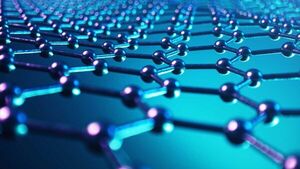
A new quantum component made from graphene
"For the first time, ETH Zurich researchers have been able to make a superconducting component from graphene that is quantum coherent and sensitive to magnetic fields. This step opens up interesting prospects for fundamental research. Less than 20 years ago, Konstantin Novoselov and Andre Geim first created two-dimensional crystals consisting of just one layer of carbon atoms. Known as graphene, this material has had quite a career since then. Due to its exceptional strength, graphene is used today to reinforce products such as tennis rackets, car tyres or aircraft wings. But it is also an interesting subject for fundamental research, as physicists keep discovering new, astonishing phenomena that have not been observed in other materials." [...]

Researchers 3D print degradable polymers using salt
"Dr. Emily Pentzer, associate professor in the Department of Materials Science and Engineering and the Department of Chemistry at Texas A&M University, is making 3D-printed polymers more environmentally friendly through a process that allows the polymers to naturally degrade over time. Pentzer’s research is a collaborative effort that includes researchers from the Texas A&M College of Engineering, the Texas A&M Engineering Experiment Station, the Texas A&M Department of Chemistry and the University of Kashmir. The research was published in the journal Angewandte Chemie. “Our goal was to create sustainable degradable polymeric structures,” Pentzer said. “We did this by leveraging the microstructures afforded by chemistry in conjunction with the macrostructures afforded by 3D printing.” Most commercial synthetic polymers consist of large molecules that do not break apart under normal conditions. When left in the environment, manufactured items such as foam cups or plastic containers break down into small pieces that are unseen by the naked eye, but the long polymer molecules remain present forever." [...]
Projetos Maker
Diversos Projetos interessantes.
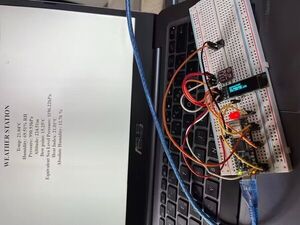
Weather station
"This project measures the temperature, humidity, atmosferic pressure (and much more... ) and display then on a web page. Hello this project uses a arduino nano 33 IOT, a BME280 and an i2c oled display. After power up, the software connects to a wifi access point and request an IP address by DHCP. Upon successfull connection, the display shows the affected IP address on the display. When connecting to the displayed IP address with a web browser, the parameter mesured from the BME280 apear on the scren and are refreshed every 5 seconds. The embbeded WebServer supports several connections and can be accessed over internet by bridging or by forwarding the appropriate port" [...]
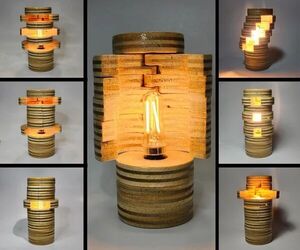
Sculptural - Customizable - Plywood Lamp
"I have been wanting to try and make this for quite some time but just never got around to it, mostly because I couldn't figure out an easy way to make the "hinge". I finally decided to just start the build and see what happens. I'm glad I did because I was able to problem solve my way through it once I was in the middle of it. And I am really pleased with how it turned out. I wanted to make a lamp that I could control how much light was being given off. Sort of like an analog dimmable light of sorts." [...]

DIY Arduino based wire cutting machine
"hello friends in this post I have build a Arduino based wire cutting machine using Nema 23 Stepper motor. This machine Automatically cut and strip the Wire as per given data provided by a small HMI. Components used: - Arduino Nano - Nema 23 Stepper Motor - TB6600 Stepper driver - Wire cutter - 12VDC 10amps SMPS - Nextion HMI" [...]

BYOPM – Bring Your Own Password Manager
"BYOPM is a portable Password Manager implementation based on VaultWarden, an unofficial implementation of BitWarden and a Raspberry PI Zero. It’s a self hosted solution, with full functionality, which is activated by just plugging the device on your computer. Bitwarden’s Official browser addons and extensions are also supported, and the device has been tested both on Windows (10 and 11) and Linux (Debian Based). Plug BYOPM to your computer using a micro usb cable, after about a minute a new network device will be automatically created and appear as connected. BYOPM hosts a Vaultwarden instance which is required for managing your passwords and also emulates an ethernet network interface card in order to be accessible from your computer without any configuration. Vaultwarden is then accessbible using your browser at https://byopm.local." [...]

Saving Power On An ESP8266 Web Server Using Delays
"ESP8266 core support on Arduino comes with a library that allows you to quickly setup and run a web server from your device. Commonly the code using the ESP8266WebServer library looks something like the following: #include <ESP8266WebServer.h> ESP8266WebServer server(80); void setup(void) { ... various wi-fi and request handler setup calls here ... } void loop(void) { server.handleClient(); } For a more concrete example, take a look at the "Hello World" example that is included with the library. In the following we'll focus on the loop() and ignore the rest. As the name implies, the Arduino framework calls the loop() function in an infinite loop. The handleClient() method checks if any client has connected over the Wi-Fi network and issued an HTTP request. If so, it handles the request and sends a response back to the client." [...]
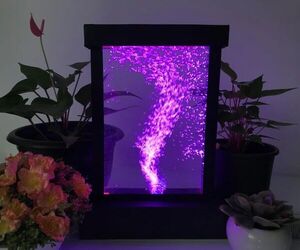
Smart WATER BUBBLES LAMP
"In this tutorial I'm going to show you how to make an amazing Smart water bubbles lamp. I focused on creating this light decoration mainly using PIXEL LEDs and water bubbles. We can be displayed million of colors and 100+ light patterns from this decoration and we can control easily this by simple mobile application via WiFi. This project is mainly control by Arduino platform. don't worry if you haven't any knowledge about Arduino because I have simply explained step by step how to make this. So having no knowledge about Arduino will not affect to make this." [...]

Visualizing Sorting Algorithms
"For my workforce development class, I show how a sorting algorithm works using NeoPixels (red larger, blue smaller). A common starting point for learning about algorithms (and their complexity - big O notation) is sorting algorithms. It dawned on my that a NeoPixel strip could be used to visually show the numbers of a Bubble Sort floating to the top. And, that this visualization could then be compared against other algorithms, such as the Quick Sort. " [...]

A VGA Computer Based on ESP32 and FabGL With Sound, Graphics
"This a home computer with VGA, sound and optional network support based on an ESP32 microcontroller. This tutorial is about building a 80s style home computer with BASIC interpreter on the basis of FabGL and the ESP32 microcontroller family. The system supports sound, graphics, and networking. Input device is a PS2 keyboard. The microcontroller hardware is a board produced by TTGO with the VGA, PS2, and audio sockets already installed.It was originally designed for retro computing and running emulators of 70s and 80s operating systems. The project here showcases a BASIC interpreter that has been newly developed." [...]
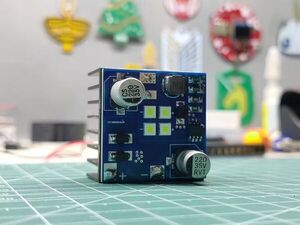
High Power LED Board
"Prepared a custom HIGH POWER LED Driver board for driving four XPLAW LEDs. It consists of Four XPLAWT LEDs that are High-Intensity LEDs each rated for 3A Max and their operating Voltage is 2.8V to 3.2V. Why LED Drivers are used? An LED could be easily powered through any DC source but what if you want a regulated source that can control the current going to LED, in such case an LED Driver is required. Also, directly powering an LED through any power source might kill the LED as LEDs have a tendency to take as much current as they can have and this usually fries the LED from the inside. LED Driver limits the current taken by LED and regulates the whole system in a linear way, Current is also controlled when the temperature gets too hot." [...]
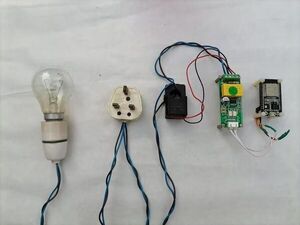
Smart Energy Consumption Meter | IoT
"This is a smart system for managing the energy consumption of separate devices based on CT Sensor. Smart Energy Consumption Meter Electricity is an essential part in the world. Nowadays electrical machinery is used every day, so the impact of the electricity consumption is an essential too. Here there is a smart device which connect with internet and shows the live energy consumption through a hosted website. However, it is also necessary to measure the power consumed by the customer, who is responsible for taking readings and generating billing. Here we have come up with an idea to solve the issue smarty." [...]
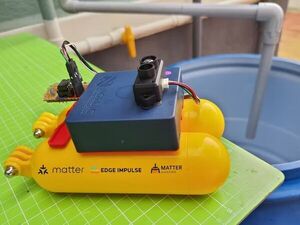
Float Bot for Water Tank
"Sensing the Water Tank with Machine Learning & Matter The Story Begins With.. It's been a year since I was not active with the hackster.io community. Just came back from the break with this new and one of my dream project. I think I should call this as products. let's get into more details and story of this idea. Noticed this contest from hackster io and decided to contribute my idea." [...]
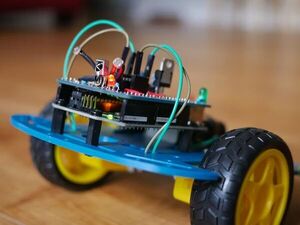
IR Remote Controlled Car Using a Protoshield
"Making a smart car kit smaller. I started a project that was worth moving from a breadboard and onto a protoshield; an IR remote controlled car using an L293D H-bridge motor driver. NOTE The story I have written below is actually the script in the video below. The video also shows three other protoshield project ideas. Additionally, the video also shows the pinouts for the IR receiver I used in the final version. Please consider watching the video first." [...]
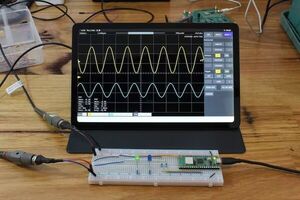
Scoppy Oscilloscope - Part 1. Getting Started
"Create a cheap and basic but usable 500kS/s oscilloscope using the Scoppy Android app connected via Wi-Fi to your Raspberry Pi Pico W. Introduction In this guide will cover how to create a basic oscilloscope using a Raspberry Pi Pico W, an Android phone (or tablet), the Scoppy Android app and Scoppy Pico W firmware. The devices communicate over Wi-Fi and so your precious phone (or tablet) never needs to be physically connected to the Pico W or the circuit under test. Whew! Assuming you already have a Pico W and Android device the extra cost is approximately USD$2. The scope will have a sample rate of 500kS/s, an input impedance of around 100k but is limited to signals with a voltage range of 0V to 3.3V. In later articles we will describe how to increase the input impedance and extend the range to include negative (and larger) voltages." [...]
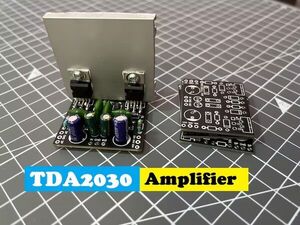
TDA2030 Amplifier Has Amazing Performance
"I made this dual channel stereo 28watt amplifier in on a small cute PCB, Powered by external 18v dual power supply and has very good audio. Today I have TDA2030 amplifier project here to share with you guys. This IC is developed by ST microelectronics and TDA series is known for its high-fidelity sound experience. TDA2030 is very old and discontinued by ST but still available due to huge stock. Some other manufacturers also making the same but Original IC has better output and stable thermals. TDA2030 is very popular because of its outstanding features which offers 14w constant output to a 4-ohm load." [...]
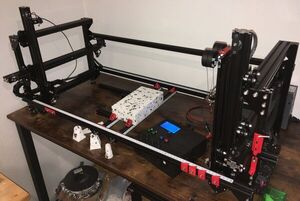
4AxisFoamCutter
"Arduino based CNC foam cutter with display and SD-Card. Ruby Script for SketchUp Make 2017 to generate gcode. Swift base post processing My goal was to build a foam based semi scale glider. So a lot of segments and very accurate working would have been necessary. This brought me to the idea to design the glider in SketchUp and build a 4 axis foam cutter. The base idea ist very simple." [...]

Simplest Stereo Preamplifier Ever
"This is the simplest amplifier works on the principle of band pass filter and no external power supply is needed. In previous tutorial I made a TDA2030 stereo based 28w amplifier. which is operated by external power supply. but how to use an amplifier without improper signal strength and frequency. That’s why preamplifiers come into market. Because I did not want more regulators/ wires and power supplies here in this circuit, I am making a preamplifier which runs without any power supply." [...]
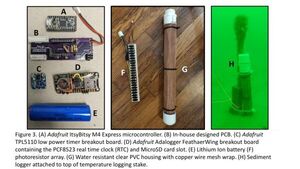
Sediment_level_logger
"Knowledge of sediment erosion and deposition can be useful for a variety of engineering, marine science, and environmental applications, but collecting detailed sediment level time-series measurements can be challenging, particularly in coastal marine environments. We developed economical and open-source sediment level loggers to record sediment level time-series data with accuracy up to 1 cm. The logger is composed of a programmable Circuit-Python (or Arduino) microcontroller and “breakout boards” that attach to a specially designed printed circuit board (PCB) and an array of evenly spaced photoresistors enclosed in a robust waterproof housing. The sediment level loggers described below, use light sensors to detect changes in the elevation of the seafloor. They are designed to be built on a low budget and provide substantial amounts of data over a long period of time with no user input after deployment. Desirable characteristics for this monitoring platform include: - Assembled from a small number of low-cost, readily available components - Supports a wide variety of analog and digital sensors - Non-proprietary software and file formats - Removable microSD storage media - User-adjustable operating parameters, such as sampling interval - Operating life span > 1 year using reusable lithium or alkaline AAA batteries - Rugged, chemically resistant environmental housing for submerged or buried deployments" [...]

The Trash Printer - Version 3
"An open-source, low-cost, large-format 3D printer that can print directly from shredded plastic trash instead of filament The Trash Printer is an open-source large-format 3D printer that can print new and useful things directly out of shredded plastic trash. Polypropylene (#5) works best, but I've also printed with HDPE and LDPE (#2 and #4) Together, these common plastics make up over 50% of all household plastic waste! The parts aren't as detailed as typical 3D printed parts, but they're incredibly strong, light, and flexible; more comparable to parts made by injection molding than those made by most desktop printers. Skipping the filament-making step entirely reduces the recycling process to just two steps: Shred, and Print. Version 3 Overview: Estimated Build Time: 12 hours Estimated Cost: $1000-1500 or $3000-3500 with solar power Energy Cost: About 1 watt-hour per gram Print Area: V3: 22" x 14" x 22" V3 Mini: 8" x 16" x 22" The Trash Printer was inspired by the Precious Plastic movement, a global, open-source, small-scale plastic recycling movement! It started with 4 open-source machines - a shredder, an extruder, an injection molder, and a compression oven." [...]
Secção Videos
Videos interessantes.
That's all Folks!



